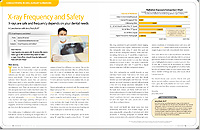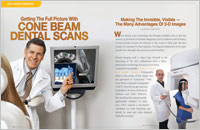The Benefits of Digital X-rays
Digital x-rays reduce radiation 80-90% compared to the already low exposure of traditional dental x-rays. Dental x-rays are a diagnostic tool in preventive dentistry that reveal areas not visible during a regular dental exam, and show problem areas may go undetected without the use of x-rays, such as abscesses, cysts, periodontal disease, decay that may not be clinically visible, and other bone or root abnormalities.
How often should dental x-rays be taken?
The need for dental x-rays depends on each patient’s individual dental health needs. Your dentist will recommend necessary x-rays based upon the review of your medical and dental history, a dental exam, signs and symptoms, your age, and risk of disease.
A full mouth series of dental x-rays is recommended for new patients. A full series is usually good for three to five years. Bite-wing x-rays (x-rays of top and bottom teeth biting together) are taken at annual check-up visits and are recommended from anywhere between once or twice a year to once every two-three years.
Contact us at our dental office in San Francisco in Pacific Heights if you have any questions or need to schedule an appointment!
Please read our Dear Doctor article about the safety of dental x-rays:
Related X-ray Articles
 X-Ray Safety For Children
X-Ray Safety For Children
Nearly every diagnostic testing procedure carries some risk, so it's always important for you and your healthcare provider to weigh the benefits against the risks. This is particularly true when it comes to children, who are more sensitive to x-rays than adults... Read Article
 X-Ray Frequency and Safety
X-Ray Frequency and Safety
Many patients have expressed concern about radiation exposure when receiving their dental X-rays. While they have wanted the diagnostic benefit of an X-ray, they have not wanted the radiation exposure. Digital X-rays eliminate that worry. Compared to traditional X-rays, digital X-rays reduce radiation exposure by as much as 85%. Read Article
 Getting The Full Picture With Cone Beam Dental Scans
Getting The Full Picture With Cone Beam Dental Scans
Dental imaging took a major leap forward at the beginning of the new millennium with a three-dimensional technology known as cone beam computed tomography (CBCT). The name comes from the cone-shaped beam of x-rays the CBCT machine projects as it rotates around a person's head, taking multiple images that are compiled into a 3-D picture by a computer. Find out what CBCT can reveal and how it helps a doctor to make a highly informed diagnosis and choice of treatment... Read Article
Back